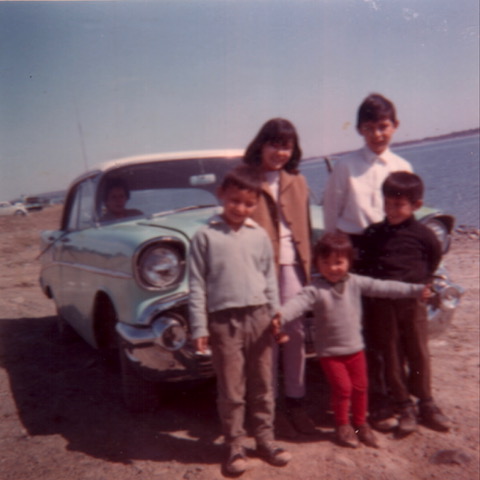Hypothetically, a child asks “Mama and Papa who is my real daddy?” In the old days, before the advent of new reproductive technologies, the answer would have been straight forward “your daddy was ____, but he left me, or we got divorced, or he is dead or I don’t really know for sure, or you were adopted and we don’t know who your biological father is.
Now, the answer can be very complicated. “Well my precious one, remember, you were always a wanted child. We spent hundreds and thousands of dollars to have you. Believe me it was not easy. The man who is your biological father was a sperm donor, we don’t really know much about him except that he did not have HIV. As for your mother, we commissioned a beautiful young woman in Romania to produce high quality eggs, and the woman who carried you in the womb was a surrogate from India. We had to travel all the way to India with the young woman who provided the eggs so that the fertilization and implantation could take place comfortably”
“So mama, technically, I have three mothers and two fathers? Right?” Unlikely scenario – yes; but improbable – no.
The fact is that it is impossible for someone to know about their genetic predisposition to diseases and whether or not they have siblings, if sperms from a donor were used many times? In fact, sperms from one particular donor resulted in 150 children! According to Debra Spar, president of Barnard College and author of “The Baby Business: How Money, Science and Politics Drive the Commerce of Conception.” “We have more rules that go into place when you buy a used car than when you buy sperm. It’s very clear that the dealer can’t sell you a lemon, and there’s information about the history of the car. There are no such rules in the fertility industry right now.” That is why there is a movement afoot, demanding that a mandatory registry of donors of eggs and sperms be maintained by the IVF clinics and the number of times a sperm specimen is used to fertilize eggs be restricted to 50 per 800,000 people in a community, to prevent co-sanguinity.
However, let us roll back in time to 1978 when Louise Brown, the first test-tube baby was born. It was heralded as a miracle; the answer to the prayers of infertile couples. The two doctors, Robert Edwards and Stephen Steptoe became instant heroes, and Edwards was amply rewarded with a Nobel Prize for medicine or physiology in 2010, for his ability to fertilize a human egg in a Petri dish and implant it in the uterus of a woman. Although, a first in humans, this procedure was quite old in cattle, super-ovulation and subsequent transfer of embryos had been practiced since the fifties and commercialized extensively because one could select the sex of the progeny depending on the purpose of raising the cattle – females, if it was for milk production and males, if it was for meat production. As well, it was easy to ship a frozen embryo across continents. All this became possible because of extensive knowledge about fertilization and reproductive biology.
In the 34 years following the birth of Louise Brown, at least four million children have been born through IVF around the globe. In the meantime, Louise has had a child by natural means. At the same time, the types of technologies used to aid birth have proliferated exponentially. Cryopreservation of embryos (first developed in cattle), intra cytoplasmic sperm insertion (ICSI) to overcome low male fertility, prenatal genetic diagnosis (PDG) are some of the techniques in use today. So science has galloped ahead at lightning speed, while philosophical and ethical questions and dilemmas about the shifting meaning of human life seem to be moving along at a snail’s pace. Cryopreservation of human embryos have now been perfected; this has further raised new ethical dilemmas and legal questions about who owns the embryos and what should be done about the extra frozen embryos.
It became amply clear to women, a short time after Louise Brown’s birth that commercial exploitation of NRTs would explode. In Canada, after considerable lobbying by feminist groups, health care advocates, family law experts, regulators, and medical service insurers, the Conservative Government of Brian Mulroney set up the Royal Commission on New Reproductive Technologies in 1989. Royal commissions are a common way of looking at multi-jurisdictional issues to develop and test a national consensus in Canada and to receive “advice”; this had the impact of delaying regulation of NRTs. The lengthy process meant that IVF clinics could carry on business as usual and introduce procedures quickly so that they could become well-established before the RC made its recommendations. Even as the Royal Commission deliberated, high profile law suits concerning surrogacy and wrongful birth were making headlines. The first of these was the case of Baby M where the surrogate refused to give up the infant after the baby was born; she lost the case and had to give up baby M. Then there was the case of mix-up of embryos in the lab and the black couple made a claim for custody of the baby born to the white couple, who were reluctant to part with the baby! This was just the tip of the ice-berg! As soon as different countries got into the business of making babies, marketing and selling of IVF services began in earnest and the ensuing problems highlighted the need to act swiftly.
The Royal Commission report, aptly titled “Proceed with care” made 293 recommendations; it banned some procedures altogether such as making of inter-species chimeras, no germ line modification, no sex-selection for non-medical purposes, and no payment for gametes etc. It proposed regulating other areas such as criteria for clinic licenses, which procedures could be done such as how many eggs to be implanted etc. But the main recommendation that an agency be set up to regulate and monitor assisted human reproduction (AHR) was delayed until the bill received Royal assent in 2003 and the Assisted Human Reproductive Agency of Canada (AHRAC) was born in 2004! AHR technologies have become normalized, the services remain privatized and the status of regulation and policy remains much as it did when the commission completed their work. Skills in AHR are considered essential for new gynecologists and couples postponing creating their families due to financial considerations, have come to believe that many of the prohibitions such as payments to gamete “donor” and surrogate “support” costs are burdensome. Even before the work of the new agency got underway, the agency’s right to oversee the implementation of regulations in the running of clinics was challenged. The Province of Quebec made a constitutional challenge that the federal government did not have the right to regulate AHR because health services came under provincial jurisdiction in 2008. There was also a human rights challenge filed in Ontario that fees for IVF services violated the Health Canada Act.
In the global marketplace of reproductive tourism, the fertility treatment packages for example in India include a trip to the Taj Mahal, with a five-star hotel-like facilities and a visit to an ayurvedic ashram thrown in for good measure. Big hospital conglomerates are wooing the European and American Market, whereas, the smaller hospitals are targeting neighboring countries like Bangla Desh, Sri Lanka and Pakistan. Joint-venture with foreign partners, like Insurance companies, is now permitted after liberalization of the Indian Economy. Currently, 51% ownership is permitted as an incentive for investing in private hospital infrastructure. International accreditation is being sought to allay fears about quality of care. The prime driver for services overseas is that procedures which would not be permitted in the home country, can be availed of in another country which either has no regulations or the providers flaunt them without impunity. The cost of services is also an important driver for reproductive tourism. In fact, medical tourism, of which reproductive tourism is a small part, is expected to gross, 2 billion USD in 2012. Other forms of trade in the baby business have surfaced that Edwards could not have dreamt of in his wildest dreams in 1978 – commercial surrogacy on an industrial scale, trade in eggs, embryonic stem cells for research and treatment and the list goes on! Although not always explicit in their advertising, some clinics offer sex-selection of embryos in several countries including India and Ukraine to provide what they call euphemistically for family balancing purposes. Sex selection diagnosis of embryos is not restricted to India and Ukraine; according to a survey conducted by Susannah Baruch, Director of Johns Hopkins University’s Genetics and Public Policy Center in 2006 a whopping 42% of the clinics in USA offered sex selection either through pre-implantation genetic diagnosis (PGD) or micro-sorting of sperms. PGD is not without risks, therefore, testing for single-gene disorders might be justified but to use it to detect the sex of the putative fetus, just because a couple doesn’t want any girls, or any boys, is troubling and ethically wrong.
Possibly the most exploitative aspect of the “brave new world” is the use of surrogates to gestate babies for an infertile couple, when the woman is unable to carry a pregnancy for any number of reasons or a gay man who wishes to father a child. A recent 2011 report titled “Surrogate motherhood: ethical or commercial” by the Centre for Social Research in India, noted that women, who undertake these assignments, usually come from poor families. They are usually married with two or three children of their own; they are lured by the amount of cash offered by a childless couple because they need the money. Even though the amount may appear to be quite small by Western standards, it can make a huge difference to the wellbeing of the family. Ironically, while the husband may consent to the woman earning money by renting her womb, often the man becomes hostile and turns against the woman and she is subjected to maltreatment and ostracization. The state of Gujarat seems to be in the lead in the provision of surrogacy services. There are reports of physicians managing the surrogacy business from start to finish!
Several high profile cases involving surrogacy in India has led the Indian Government to take some action to regulate the industry. For example a commissioning couple refused to take custody of a child because the baby had a birth defect; the surrogate did not want the baby either. So the child was abandoned and sent to an orphanage. Likewise, a Japanese couple used a surrogate to implant an embryo, the product of an egg from the woman and sperm from the man, but even as the pregnancy was half way through, the couple filed for divorce and the woman did not want to have anything to do with the child. However, the man, who wanted the child, could not take custody because single men are not permitted to adopt under the Indian law. The child remained in India for almost two years until the paternal grandmother agreed to take custody of the child. In another instance, a German couple who commissioned a surrogate to bear a child for them could not get a German passport for the baby because he was not related by blood to either of them. As a consequence the Assisted Reproductive Technique bill was introduced in 2010; it laid down some 24 guidelines for surrogacy arrangements. One such guideline states “A foreigner or foreign couple not resident in India, or a non-resident Indian individual or couple, seeking surrogacy in India shall appoint a local guardian who will be legally responsible for taking care of the surrogate during and after the pregnancy as per clause 34.2, till the child / children are delivered to the foreigner or foreign couple or the local guardian. Further, the party seeking the surrogacy must ensure and establish to the assisted reproductive technology clinic through proper documentation (a letter from either the embassy of the Country in India or from the foreign ministry of the Country, clearly and unambiguously stating that (a) the country permits surrogacy, and (b) the child born through surrogacy in India, will be permitted entry in the Country as a biological child of the commissioning couple/individual) that the party would be able to take the child / children born through surrogacy, including where the embryo was a consequence of donation of an oocyte or sperm, outside of India to the country of the party‘s origin or residence as the case may be. If the foreign party seeking surrogacy fails to take delivery of the child born to the surrogate mother commissioned by the foreign party, the local guardian shall be legally obliged to take delivery of the child and be free to hand the child over to an adoption agency, if the commissioned party or their legal representative fails to claim the child within one months of the birth of the child. During the transition period, the local guardian shall be responsible for the well-being of the child. In case of adoption or the legal guardian having to bring up the child, the child will be given Indian citizenship”. This only ensures that there is legal protection for the government but not much to protect the rights and interests of the surrogate, the child, or the commissioning parents.
Health risks of IVF continue to be big concern for example: Do they have more birth defects?
Are they more or less intelligent? Are they more prone to autism? Do they have a higher incidence of cancer? Undoubtedly, multiple births resulting in high risk pregnancies with poor outcomes have been documented in large number of studies. The use of ICSI to fertilize an egg has been shown to affect the fertility of the progeny. Unfortunately, as the numbers of IVF children increase by the millions, there is no easy way to track if there are long term consequences.
The possibility of “designer babies” has been the substance of many science fiction novels, from Aldous Huxley’s Brave New World to Margaret Attwood’s Handmaid’s tale to John Wyndham’s Midwich Cuckoos. The dystopias crafted in these novels, create a world that mirrors the reality of the “baby for profit” business in the world today. IVF may have made it possible for some people to experience the joy of parenthood and creating families but the commodification of children, the sale of sperms and eggs, use of pre-implantation genetic diagnosis for sex selection purposes, and surrogacy are the most troubling aspects of ART and we need a vigorous debate on what kind of world do we envision for future generations.










